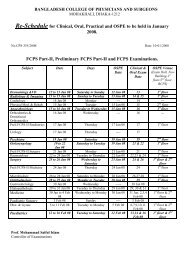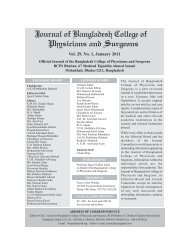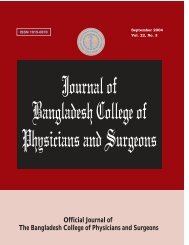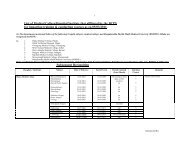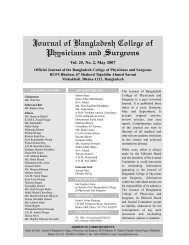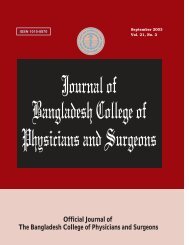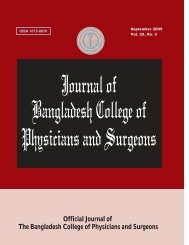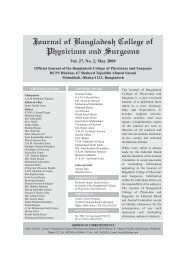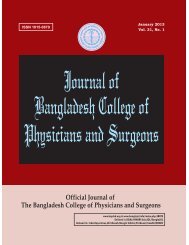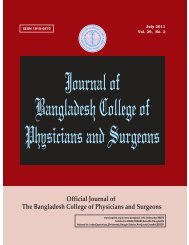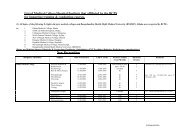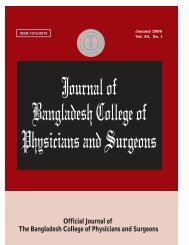May 2008 - bcps
May 2008 - bcps
May 2008 - bcps
Create successful ePaper yourself
Turn your PDF publications into a flip-book with our unique Google optimized e-Paper software.
Approach to Subclinical Thyroid DiseaseIn one report, the risk of vertebral fracture waselevated 4- fold and hip fracture was elevated 3- foldin women of 65 years of age or older with serumTSH values 0.1 mIU / L or less compared withcontrol. 29Recently, two studies described an increase in typicalhyperthyroid symptoms (Palpitation, tremor, heatsensitivity, sweating, and nervousness) in young &middle aged patients with sub clinicalhypothyroidism.19, 23In a community- based study of persons age 65 years& older, there were no significant differences inmood, anxiety or cognition between sub clinicalhyperthyroid persons & those who were euthyroid 30 .One study showed an increased basal oxygenconsumption that decreased to normal after treatmentwith methimazole. 31 In another study, patients withsub clinical hyperthyroidism were found to havedecreased muscle strength compared with control. 32The risk of progression of overt hyperthyroidismvaries. The etiology plays a role in this regard.Woeber 33 observed that serum TSH values normalizedin five of seven patients with Graves’ disease andsubclinical hyperthyroidism followed for 3-19months, whereas it remained subnormal in patientswith multinodular goiters followed for 11-36 months.Evaluation of Subclinical Hyperthyroidism :Individuals With Serum TSH 0.1 to 0.45 mIU/L NotTreated With Levothyroxine. Measurement should berepeated by measuring FT 4and either total T 3or FT 3levels. Repeat testing within 2 weeks is prudent forpatient with atrial fibrillation, cardiac disease, orother serious medical conditions. Repeat testingwithin 3 months is recommended, when these factorsare absent. 3If the repeat serum TSH concentration remains higherthan 0.1 but lower than 0.45 mIU/L, with normal FT 4and T 3concentrations, and the patient has no signs orsymptoms of cardiac disease, atrial fibrillation, orother arrhythmias, retesting should occur at 3- to 12-month intervals, until either serum TSH levelnormalizes or the clinician & patient are confidentthat the condition is stable. 3Individuals With a Serum TSH Lower Than 0.1mIU/L. The measurement is repeated along with anFT 4and a total T 3or FT 3within 4 weeks if the patienthas no signs or symptoms of cardiac disease, atrialfibrillation or other arrhythmia but within a shorterinterval if signs or symptoms of hyperthyroidism arepresent. 3The panel recommendts further evaluation toestablish the etiology of the low serum TSH. 3A radio-active iodine uptake & Thyroid scan candistinguish between destructive thyroiditis &hyperthyroidism due to Graves’ disease or nodularGoiter.Risks of Treatment of Subclinical Hyperthyroidism:The risks of treatment with antithyroid drugs arepotential allergic reactions including agranulocytosis.Radioactive iodine therapy commonly causeshypothyroidism & may cause exacerbation ofhyperthyroidism or Graves’ eye disease. 34Treatment:SR SutradharExogenous Subclinical Hyperthyroidism With TSH0.1 to 0.45 mIU/L.The indication of thyroid hormone therapy should bereviewed. Many patients with thyroid cancer & somepatients with thyroid nodules required TSHsuppression and target TSH level should be reviewedby the treating physician. When prescribed for othercauses the dosage of levothyroxine is decreased toallow serum TSH to increase toward the referencerange. 3Exogenous Subclinical Hyperthyroidism With TSHLower Than 0.1 mIU/L.The indication for thyroid hormone therapy should bereviewed. For patients with thyroid cancer andthyroid nodules, the target serum TSH value shouldbe reviewed by the physician. When levothyroxine isprescribed for hypothyroidism in the absence ofthyroid nodules or thyroid cancer, the panelrecommends decreasing the dosage of levothyroxineto allow serum TSH to increase toward the referencerange. 3Endogenous Subclinical Hyperthyroidism (SerumTSH 0.1-0.45 mIU/L)The panel 3 recommends against routine treatment forall patients whose TSH is mildly decreased (0.1-0.45mIU/L). Because of a possible association with94



